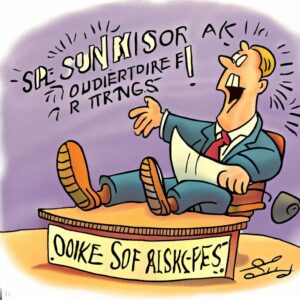In this article, we will discuss the risks of sole proprietorship that every business owner should be aware of. As a business CEO or entrepreneur, starting and managing your own business can be rewarding, but it also comes with inherent risks. One of the most common business structures is the sole proprietorship, which is owned and operated by one individual and offers simplicity and flexibility.
Nevertheless, this structure also poses risks such as unlimited personal liability, difficulty in raising capital, limited life span, lack of credibility, and challenges in hiring employees. Therefore, before choosing a business structure, it’s essential for entrepreneurs to evaluate the benefits and risks associated with each option to make informed decisions that align with their goals and values.
What is Sole Proprietorship?
A sole proprietorship is a simple and popular business structure where an individual owns and runs the business. As the sole owner, they have complete control over the company’s management, operations, and profits. However, one of the significant drawbacks of this structure is that the owner is personally liable for all the business’s debts, liabilities, and legal obligations, putting their personal assets at risk in case of financial troubles or lawsuits.
Furthermore, since the business is not a separate legal entity from the owner, the income earned by the sole proprietorship is taxed as part of the owner’s personal income tax return. This means that the owner is responsible for paying taxes on the business’s net income at the individual income tax rate, which can be higher than corporate tax rates.
Despite these challenges, sole proprietorship offers several benefits, such as simplifying the business’s legal and accounting requirements, flexibility in making quick decisions, and minimal regulatory compliance requirements. Additionally, the owner has full control over the company’s direction and can choose to incorporate or form an LLC if they wish to expand the business later.
While a sole proprietorship may offer simplicity and control, it also comes with risks such as unlimited personal liability and higher personal income tax rates. Therefore, entrepreneurs must carefully weigh the benefits and drawbacks of this business structure before choosing it as the best option for their business needs.

Risks of Sole Proprietorship
1 – Unlimited Personal Liability
Unlimited personal liability is perhaps the most significant risk associated with sole proprietorship. As a sole proprietor, the owner is responsible for all of the business’s debts, legal obligations, and liabilities. Unlike other business structures, where the owner’s liability is limited to the amount of their investment in the business, sole proprietors’ personal assets are vulnerable to being seized to satisfy any outstanding debts or legal judgments against the business.
The implications of this unlimited personal liability can be severe. In the event that the business incurs significant debt or is sued for damages in a lawsuit, the owner’s personal savings, investments, and even their home could be at risk. This risk is particularly concerning as it could result in the complete loss of everything the owner has worked hard to accumulate, leaving them with nothing.
Additionally, this risk can also impact the owner’s personal credit score and financial reputation, making it difficult to obtain loans or credit in the future. The potential consequences of these risks make it imperative for sole proprietors to take steps to limit their exposure to liability, such as purchasing liability insurance, incorporating the business, or forming an LLC.
While sole proprietorship may offer simplicity and flexibility, the risk of unlimited personal liability is a crucial factor to consider when deciding on the best business structure for your needs.

2 – Difficulty in Raising Capital
One of the significant challenges faced by sole proprietors is the difficulty in raising capital. Unlike other business structures such as corporations or partnerships, where multiple individuals can contribute funds to the business, a sole proprietor must rely solely on their personal savings, investments, and loans to finance their business operations.
Moreover, lenders and investors may be hesitant to lend money to sole proprietors because of the unlimited personal liability associated with this structure. Since the owner is personally responsible for all the business’s debts and legal obligations, lenders and investors may view sole proprietorship as a higher risk investment. Additionally, it may be challenging to demonstrate the long-term sustainability of the business, especially if the owner lacks a solid track record or has limited collateral.
As a result of these challenges, sole proprietors may struggle to secure funding for growth opportunities, such as expanding operations or investing in new products or services. This can limit their ability to compete with larger businesses and stifle their potential for success.
To overcome these challenges, sole proprietors may need to explore alternative financing options, such as crowdfunding or microloans, that are better suited to their unique needs. Additionally, they may want to focus on building a strong credit history, establishing relationships with lenders and investors, and creating a comprehensive business plan that outlines their growth strategy and financial projections.
While sole proprietorship offers many benefits, including simplicity and flexibility, the difficulty in raising capital is a crucial factor to consider when deciding on the best business structure for your needs.

3 – Limited Life Span
One of the most critical factors that sole proprietors must consider when deciding on their business structure is the limited life span inherent in this model. Since the success of a sole proprietorship depends entirely on the owner’s ability to operate the business, the continuity of the enterprise is at risk should the owner experience illness, disability, or death.
In the event that the owner becomes unable to manage the business for any reason, it may be necessary to close the company and liquidate its assets to pay off any outstanding debts or liabilities. This can be a challenging and complicated process, especially if the business has significant inventory, equipment, or real estate holdings. Moreover, the sudden cessation of operations can have a negative impact on suppliers, customers, and employees, leading to reputational damage, loss of goodwill, and potential legal issues.
To mitigate these risks, sole proprietors may want to develop a succession plan that outlines how the business will continue in the event of the owner’s incapacity or death. This may involve designating a trusted family member or colleague to take over day-to-day operations, creating a buy-sell agreement to ensure a smooth transfer of ownership, or incorporating the business to separate personal and professional assets.
While sole proprietorship offers simplicity and flexibility, the limited life span of this business structure is a critical factor to keep in mind when weighing the benefits and risks of different options. By developing a solid succession plan and considering alternative structures such as incorporation or forming an LLC, sole proprietors can help ensure the long-term viability of their business and safeguard against unexpected events.

4 – Lack of Credibility
One of the significant risks associated with sole proprietorship is the lack of credibility that this business structure may face in the eyes of potential customers, suppliers, and investors. Due to their size and simplicity, sole proprietorships may be perceived as less professional compared to other business structures, such as corporations or LLCs.
This lack of credibility can have a negative impact on a sole proprietor’s ability to attract and retain clients. Customers may be hesitant to do business with a company that appears unprofessional or lacks the resources to deliver quality products or services. Additionally, suppliers and vendors may be reluctant to extend credit or offer favorable payment terms to a sole proprietorship, which could limit the company’s growth potential.
To address these concerns, sole proprietors must take steps to establish a professional image for their business. This may include developing a comprehensive business plan, creating an effective marketing strategy, and investing in branding and advertising initiatives to enhance their reputation. Moreover, building strong relationships with customers, suppliers, and stakeholders can help demonstrate the company’s commitment to quality and reliability, which can improve its credibility over time.
Finally, it may be beneficial for sole proprietors to consider alternative business structures that offer greater credibility, such as incorporation or forming an LLC. These options can help create a perception of professionalism and stability that can attract more customers and investors, thereby improving the company’s long-term prospects.
While sole proprietorship offers simplicity and flexibility, the lack of credibility associated with this business structure is a critical factor to consider. By taking proactive steps to establish a professional image and considering alternative business structures, sole proprietors can overcome these challenges and position their companies for success.

5 – Difficulty in Hiring Employees
One of the significant challenges faced by sole proprietors is attracting and retaining qualified employees. Unlike larger businesses, sole proprietors may lack the resources to offer competitive salaries, health insurance, retirement plans, and other benefits that are common in many workplaces today.
This difficulty in hiring employees can be particularly challenging for sole proprietors who require specialized skills or expertise to operate their business successfully. Without access to a pool of talented professionals, sole proprietors may struggle to keep up with larger competitors or meet the demands of their customers.
To address these concerns, sole proprietors may want to explore alternative strategies for attracting and retaining top talent. This may include offering unique perks or incentives such as flexible work schedules, telecommuting options, or professional development opportunities. Additionally, building a positive company culture that emphasizes work-life balance, employee recognition, and open communication can help create a more desirable workplace environment for potential employees.
Moreover, sole proprietors may consider partnering with other businesses or contractors to outsource certain tasks or projects. This can help provide access to specialized talent and reduce the burden on the sole proprietor’s existing workforce.
While sole proprietorship offers simplicity and flexibility, the difficulty in hiring employees is a critical factor to keep in mind when evaluating different business structures. By exploring creative solutions for attracting and retaining top talent, sole proprietors can overcome these challenges and build successful, thriving businesses.

Conclusion
To summarize, while sole proprietorship offers simplicity and flexibility, it also comes with inherent risks such as unlimited personal liability, difficulty in raising capital, limited life span, lack of credibility, and challenges in hiring employees. It is crucial for entrepreneurs to carefully consider these risks before choosing a business structure that suits their needs. By weighing the benefits and drawbacks of different options, entrepreneurs can make informed decisions that minimize risk and maximize their chances of success.
Sources
- U.S. Small Business Administration (https://www.sba.gov/business-guide/launch-your-business/choose-business-structure)
- Cornell Law School Legal Information Institute (https://www.law.cornell.edu/wex/sole_proprietorship)
